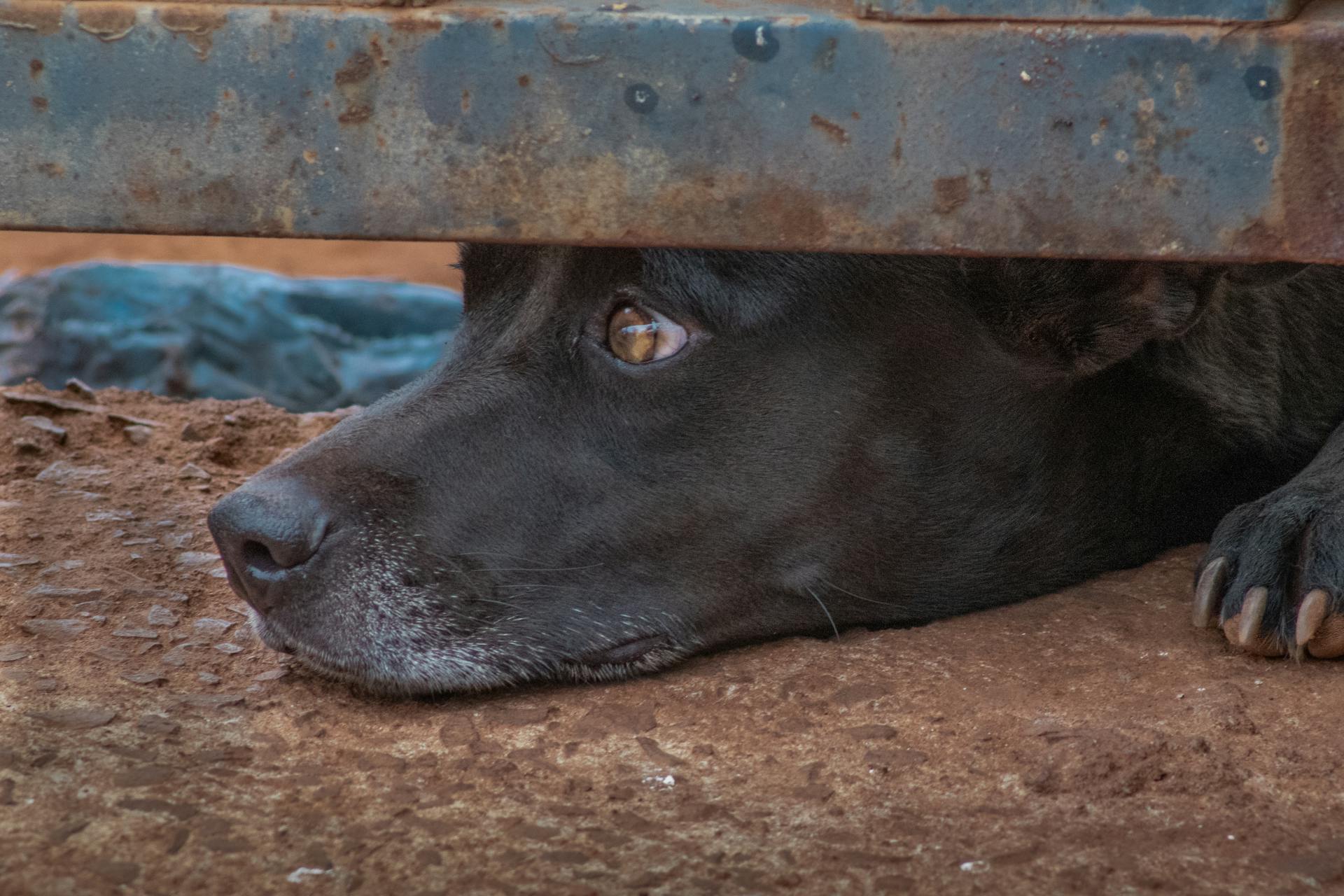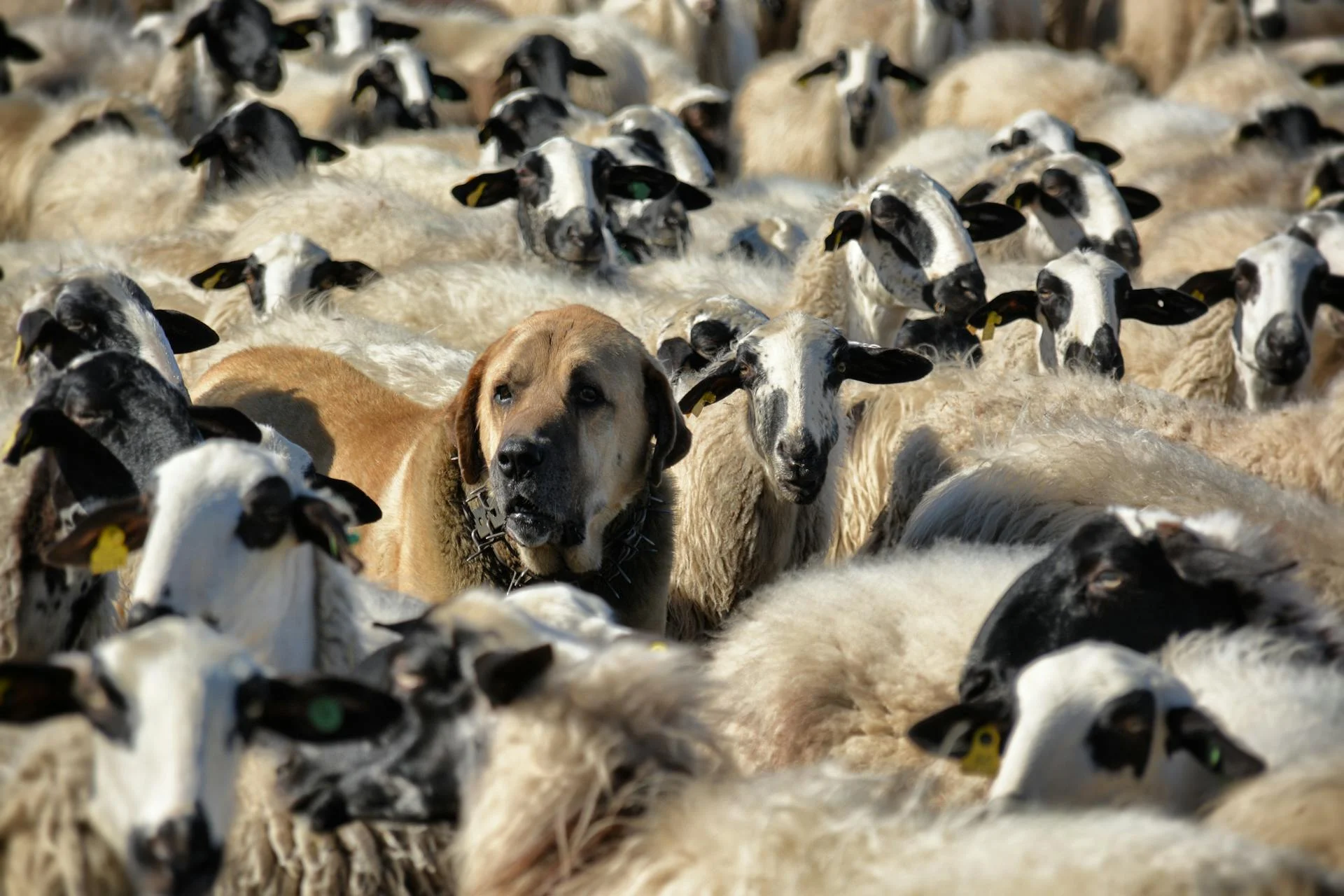
Identifying abnormal dog behavior can be a challenging task, especially for first-time dog owners. According to research, one in five dogs exhibits abnormal behavior at some point in their lives.
Dogs may exhibit abnormal behavior due to various reasons such as genetics, environment, and medical conditions. In fact, studies have shown that dogs with anxiety disorders are more likely to exhibit abnormal behavior.
Some common signs of abnormal dog behavior include changes in appetite, sleep patterns, and social interactions. For example, a dog that was once friendly but now avoids social interactions may be exhibiting abnormal behavior.
What Are
Rage syndrome is a sudden and intense form of dog aggression, classified as idiopathic aggression because there's no clear reason for the aggressive behavior.
This type of aggression is often seen in certain breeds, including English Springer Spaniels, where it's referred to as "Springer Rage." It's also found in other breeds, such as Cocker Spaniels, Doberman Pinschers, and German Shepherds.
Discover more: Rear Dew Claws on Dogs Breeds
Rage syndrome typically occurs between 1-3 years old and is characterized by a sudden onset of intense, explosive, and extremely aggressive behavior. The dog may also display a glazed or possessed look in its eyes just prior to the episode.
The possible genetic component of rage syndrome is suggested by its prevalence in certain breeds, including St. Bernards, Lhasa Apsos, and Bernese Mountain Dogs.
Some theories suggest that the narrow bone structure in certain breeds, such as Doberman Pinschers, may be causing physical damage to the brain, leading to unpredictable behavior.
Here are some breeds that are commonly affected by rage syndrome:
- English Springer Spaniels (also known as "Springer Rage")
- Cocker Spaniels (also known as "Cocker Rage")
- Doberman Pinschers
- German Shepherds
- Bernese Mountain Dogs
- St. Bernards
- Lhasa Apsos
Causes and Risk Factors
Genetic predisposition can play a role in abnormal dog behavior, with certain breeds being more prone to certain disorders. For example, Dobermans have a higher than average chance of developing obsessive disorders like flank sucking and narcolepsy.
Physical disorders can also cause symptoms that resemble mental disorders. Thyroid problems, for instance, can lead to hyperkinetic behavior.
Take a look at this: Can Dogs Have Eating Disorders
Improper socialization early in life can cause some disorders, like social anxiety, to appear. Trauma during the dog's prenatal or neonatal development stage can also contribute to abnormal behavior.
Some experts believe that seizures are part of the problem with idiopathic aggression, which can cause confusion and aggressive behavior in dogs.
Discover more: Can Wet Food Cause Diarrhea in Dogs
Causes of Rage Syndrome
Rage syndrome is a complex and mysterious condition, and understanding its causes is crucial for prevention and treatment. Researchers have proposed several theories over the years, but one of the earliest ideas was that it might be related to the breeding of certain dog breeds with narrow heads.
This theory suggests that breeds like Collies, Borzoi, and Doberman Pinschers were being bred for increasingly narrow heads, which could be putting pressure on the brain and causing unpredictable behavior. This idea is still being explored, but it's essential to note that it's not the only possible cause.
Curious to learn more? Check out: Dog Breeds Watch Dogs
In fact, any neurological problem that affects a dog's brain can lead to sudden personality changes, which are a hallmark of rage syndrome. This means that the condition can be caused by a range of underlying issues, including epilepsy and other neurological disorders.
Some breeds are more prone to rage syndrome than others, with English Springer Spaniels being the most commonly affected. In fact, it's so common in this breed that it's often referred to as "Springer Rage." Other breeds, such as Cocker Spaniels, Doberman Pinschers, and German Shepherds, are also at higher risk.
Here are some breeds that are more likely to develop rage syndrome:
- English Springer Spaniels
- Cocker Spaniels (also known as "Cocker Rage")
- Doberman Pinschers
- German Shepherds
- Bernese Mountain Dogs
- St. Bernards
- Lhasa Apsos
These breeds may be more susceptible to rage syndrome due to a possible genetic disorder or component. While the exact cause is still unclear, understanding the breeds at higher risk can help dog owners and breeders take preventative measures.
Risk Factors
Dogs with a genetic predisposition, like Dobermans, may be more likely to develop certain behavioral problems.
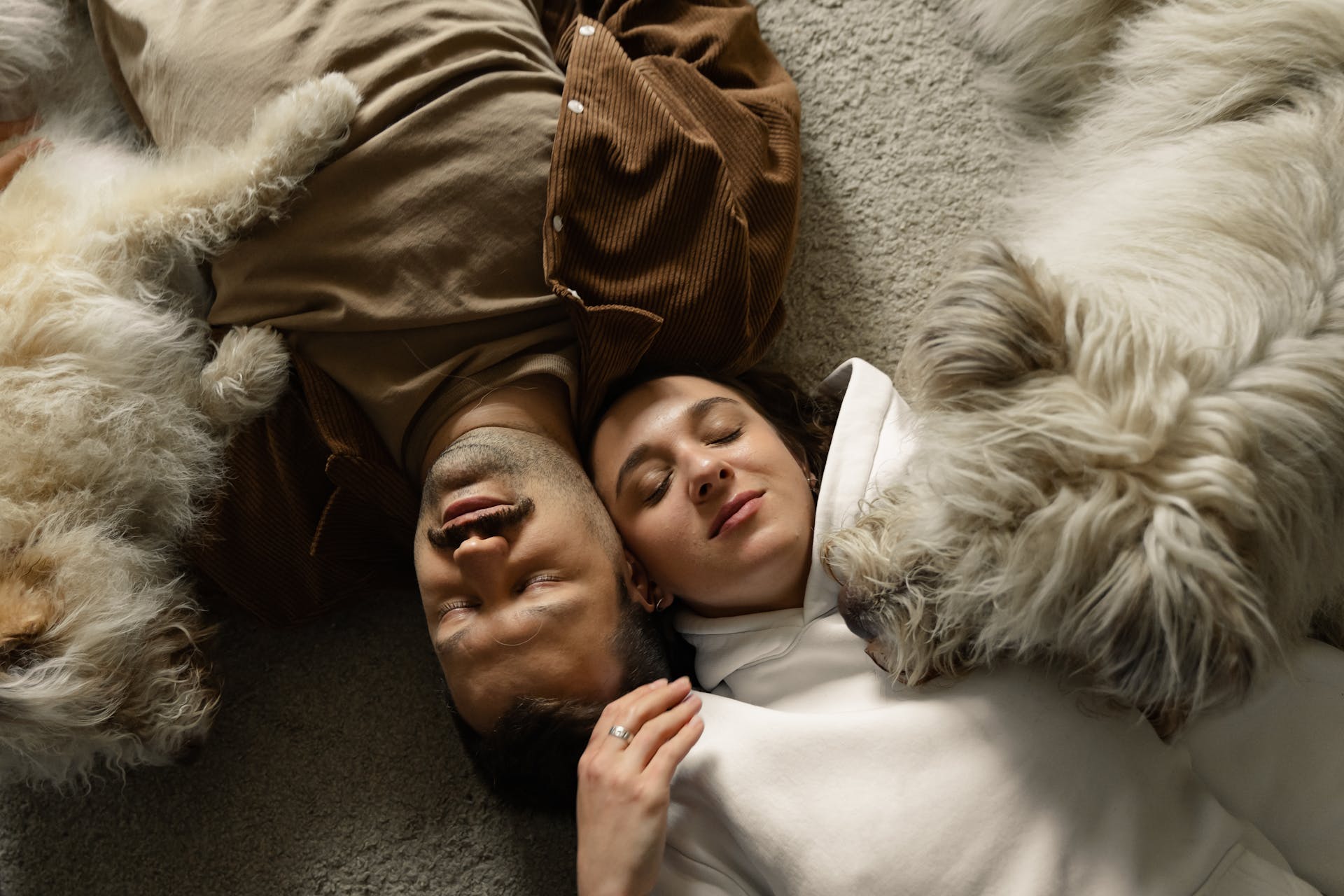
Genetic predisposition can play a significant role in a dog's mental health. Certain breeds are more prone to developing specific disorders.
Some physical disorders, such as thyroid problems, can cause symptoms that mimic mental health issues in dogs. For example, hyperkinetic behavior.
Improper socialization early in life can lead to behavioral problems like social anxiety. This is especially true if a dog experiences trauma during its prenatal or neonatal development stage.
Traumatic events, such as violent physical attacks or the loss of a loved one, can trigger depression and PTSD in dogs.
Intriguing read: Dog Health News
Pain Causes
Dogs can become aggressive due to various medical issues that cause pain or increase irritability. Dental disease, arthritis, and trauma are just a few examples.
Pain from dental disease can lead to aggression in dogs, especially when they're handled or anticipate handling. Allergies can also contribute to irritability and aggression.
Organ dysfunction, such as kidney or liver problems, can cause irritability and aggression in dogs. Central Nervous System (CNS) disease can also lead to similar symptoms.
Hypothyroidism, a condition where the thyroid gland doesn't produce enough hormones, can cause aggression in dogs, particularly towards family members. However, excessive supplementation can lead to a hyperthyroid state, which can have serious consequences.
Discover more: Periodontal Disease in Chihuahuas
Diagnosis
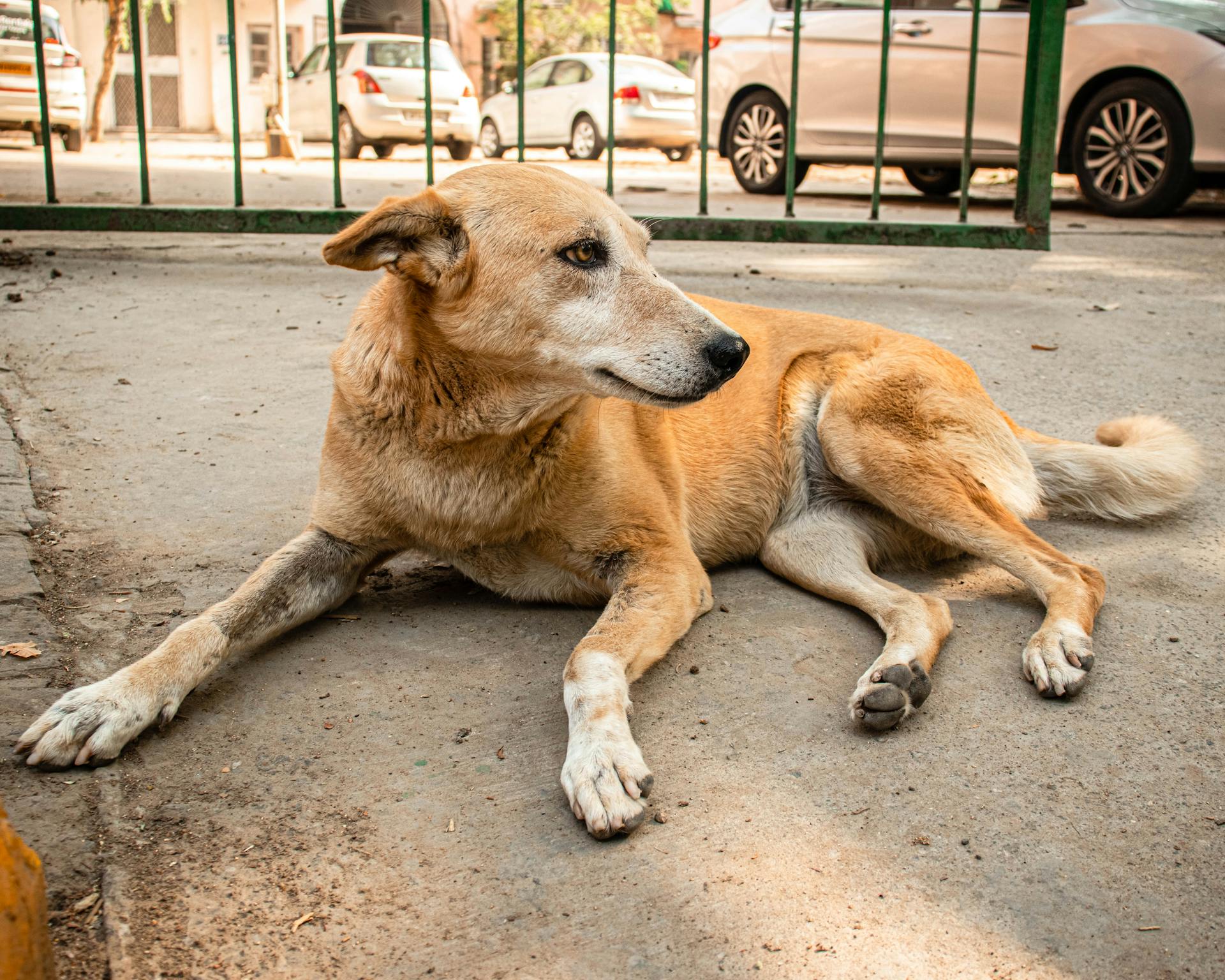
A diagnosis for your dog's behavioral changes requires a veterinary neurologist to pinpoint the exact condition and cause. This is crucial for determining the best course of treatment and gauging the dog's likelihood of recovery.
High-field MRI is the safest and most accurate imaging tool for viewing and diagnosing your dog's brain, ruling out other possible causes of the behavior. A veterinary neurologist will use this tool to show the extent of any damage and the overall severity of the condition.
To diagnose behavioral problems in dogs, a veterinarian will take a behavioral history, including information about the breed, sex, and age of the canine, as well as the duration and frequency of the symptoms. Your dog's doctor will also want to know if there have been any recent changes to your pet's medications or diet.
A physical examination will be completed, including a complete blood count, biochemistry profile, and urinalysis, to determine if there is a medical component to the behavior. Blood levels of thyroxine concentrations may also be measured, especially if thyroid disorders are suspected.
Intriguing read: Dog Blood Work Results
Aggressive Behavior
Aggressive behavior in dogs can be a complex and concerning issue. Idiopathic aggression, for example, is a type of aggression that is still not fully understood, and research suggests it may be linked to seizures, brain damage, or genetics.
Some dogs may exhibit a "hard stare" or "freeze" before an aggressive outburst, which can be a warning sign of impending aggression. Other warning signs include a still, rigid body, lunging forward or charging, guttural barks, snarls, or growling, and showing teeth.
Territorial or protective aggression may be displayed when a dog is approached in its territory, and it may not display fear to similar stimuli when outside its territory. This type of aggression can be triggered by learning and fear conditioning.
A unique perspective: Dog Behaviour When Owner Pregnant
Warning Signs of Dog Behavior
Dog owners often report a glazed look in their dog's eyes before an aggressive outburst. This can be a crucial warning sign, but there are others to look out for.
A still, rigid body can be a sign of impending aggression, as can certain movements like lunging forward or charging at the object of their aggression. Your dog might also show their teeth.
Guttural barks, snarls, or growling are all sounds that can indicate aggression. A muzzle punch, where your dog punches you with their nose, is another warning sign.
Hard nipping and biting are clear signs of aggression, ranging from nips with significant pressure to repeated bites and biting and shaking. These behaviors can be a sign of underlying issues that need to be addressed.
If you notice any of these warning signs, it's essential to take note and identify the specific form of aggression you're dealing with, as this will affect how to treat the problem.
Aggressive Behavior Classification
Idiopathic aggression is a mysterious and frustrating phenomenon that can be challenging to understand and address. It's characterized by sudden, violent, and short-lived rage, often without a clear cause or trigger.

Some researchers believe that idiopathic aggression might be related to seizures or brain damage, which could lead to abnormal electroencephalogram readings. However, not all dogs exhibiting this behavior have abnormal EEGs.
Status-related aggression, also known as dominance aggression, typically appears around 1-3 years of age, which coincidentally is also a common age for idiopathic epilepsy to develop. This similarity has led some experts to question whether idiopathic aggression is simply a misunderstood form of status-related aggression.
Dogs exhibiting idiopathic aggression may display a glazed look in their eyes, which is often described as a "hard stare" or "freeze" by animal behaviorists. This warning sign can precede an aggressive outburst.
Other warning signs of dog aggression include a still, rigid body, lunging forward or charging at the object of their aggression, guttural barks, snarls, or growling, and showing their teeth. Some dogs may even give their owners a "muzzle punch" or mouth them to try to control them.
Territorial or protective aggression is a distinct type of aggression that occurs when a dog feels threatened or defended in its territory, which can be stationary or mobile. This behavior is often triggered by unfamiliar stimuli and can be a result of learning and fear conditioning.
Aggression between dogs in the same household is generally an abnormal behavior caused by fear, anxiety, redirected aggression, impulse dyscontrol, or poor intraspecific communication skills.
You might like: Healthy Mind Canine - Separation Anxiety Training
Play
Play is a normal part of a puppy's behavior, but it can sometimes get out of hand. Aggressive play is a normal puppy behavior that may persist into adulthood as a result of genetics, neotinization, and learning.
Puppies may nip and bite during play, but they usually resolve conflicts among themselves. However, if the problem becomes excessive, owner intervention is required to redirect the dog's activities into other forms of play.
Redirecting play into other forms of play can be as simple as giving your puppy a toy to chew on or playing a game of fetch. Regular alternative acceptable forms of play, including tug games and manipulation and chew toys, are also essential.
Punishment should not be used to stop play, as it can lead to fear of the owner or defensive aggression. Instead, use positive reinforcement, such as giving your puppy a treat when they stop biting, to encourage good behavior.
Teaching your puppy to sit before giving them anything of value, like food or toys, can also help prevent play aggression. By doing so, you're teaching them that good behavior is rewarded and bad behavior is not.
For another approach, see: Puppy Strangles Long Term Effects
Irritable Conflict
Aggression directed toward family members is often mislabeled as dominance or status-related aggression, but it generally arises from fearful or defensive behaviors, resource guarding, redirected behavior, or situations of conflict.
The problem may be traced back to the owner's attempts to inhibit excessive play aggression, which can actually make the dog more aggressively defensive. This can lead to a downward spiral in the owner-pet relationship, with the dog becoming more wary and defensive, and the owner becoming more fearful and confrontational.
Genetic factors and early experience likely play a role in irritable conflict aggression, as many of these dogs are easily aroused, excessively fearful, or may have emotional disorders or behavioral pathology. In some cases, aggression is a learned behavior, resulting from a combination of fear conditioning and underlying conflict.
Dogs with irritable conflict aggression may respond with aggression to relatively benign interactions with family members, such as grabbing the collar or during bathing, nail trimming, or ear cleaning. This is a defensive response, and interrupting a pet that is aroused may lead to redirected aggression.
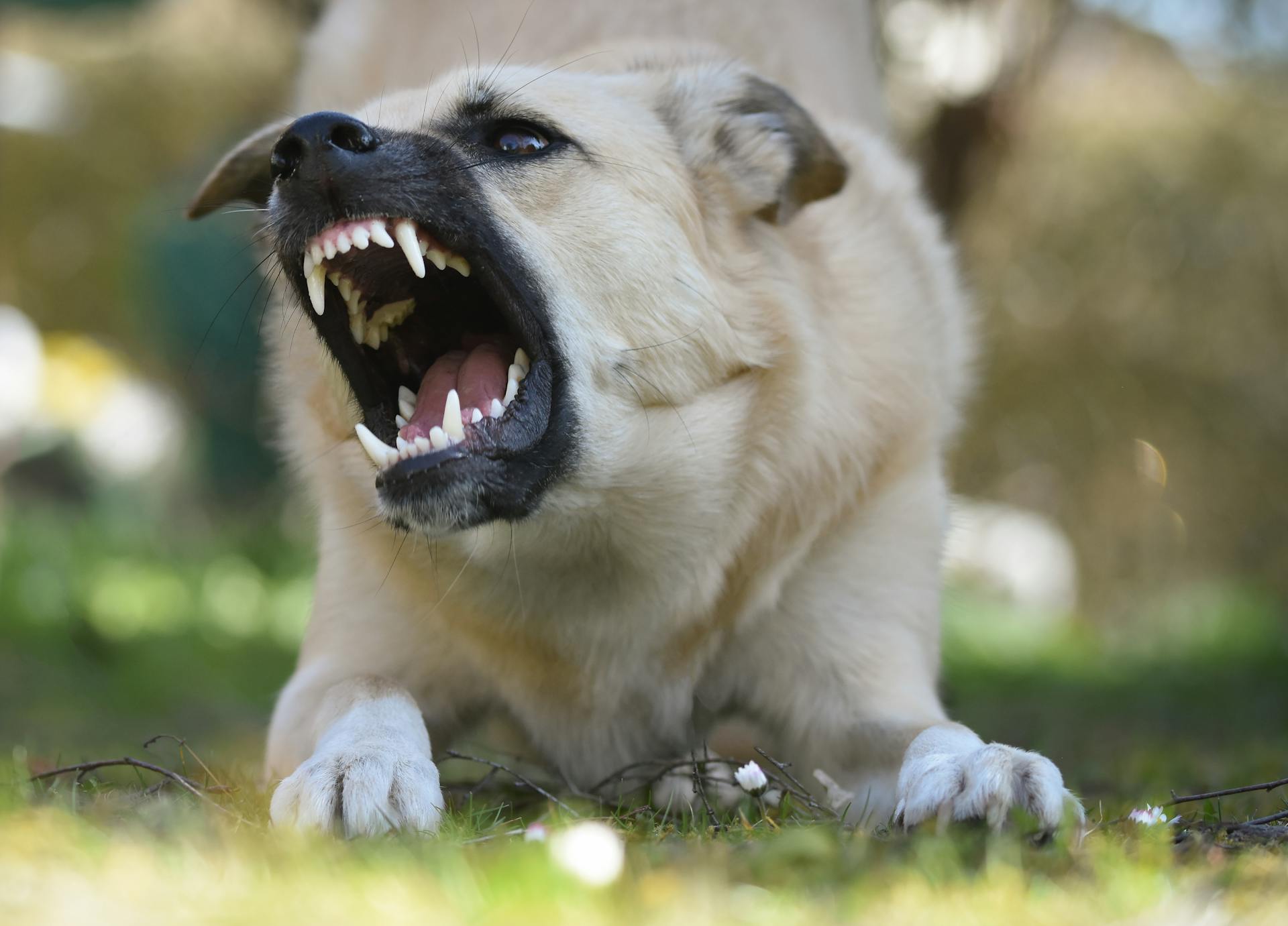
Dominance is a relative concept, and relationships between dogs and people are established through early socialization, personality, and what the dog learns from its observations and interactions with family members. Physical techniques intended to assert dominance, such as pinning or rolling over, and verbal discipline, like yelling "no", are ill advised and can result in fear, anxiety, and further aggression.
In some lines of English Cocker Spaniels and English Springer Spaniels, irritable conflict aggression is associated with alterations in serotonin in blood samples or CSF.
See what others are reading: Tail Docking Cocker Spaniels
Behavioral Disorders
Behavioral disorders in dogs can manifest in various ways, including compulsive behaviors, anxiety disorders, and phobias. These disorders can be triggered by genetics, environmental factors, or a combination of both.
Some common signs of behavioral disorders in dogs include compulsive licking, excessive tail chasing, and inappropriate elimination. These behaviors may be indicative of underlying compulsive disorders, such as compulsive licking or flank sucking, which can be caused by altered serotonin transmission.
Dogs with separation anxiety or other fears and phobias may also exhibit abnormal behaviors, such as soiling during stressful times. It's essential to identify the underlying cause of these behaviors and address them promptly to prevent further complications.
Compulsive disorders in dogs can be classified into different categories, including ingestive, dermatologic/self-trauma, and neurologic behaviors. These categories can help determine the underlying cause of the disorder and guide treatment options.
Here are some common symptoms of behavioral problems in dogs:
- Compulsive licking
- Drop in appetite
- Easily startled
- Excessive tail chasing
- Inappropriate eating
- Inappropriate elimination
- Lethargy
- Obsessive chasing behaviors
- Overeating
- Oversleeping
- Pacing
- Unwarranted aggressive displays
Maternal
Maternal aggression can be a serious issue in intact female dogs with a litter of puppies. It's essential to recognize the signs of aggression, which can be directed towards people or other animals.
The aggression typically arises when the bitch's puppies or toys that mimic puppies are protected. This behavior should resolve when the hormonal state returns to normal and/or the puppies are weaned.
Maternal aggression can be a recurring problem, especially after a first litter, and may have a genetic component. Ovariohysterectomy can prevent further incidents.
A fresh viewpoint: What to Feed Dogs If No Dog Food
Family Members or Other Animals
It's relatively rare for dogs to direct aggression toward family members or other pets in the home.
Dogs are more likely to be aggressive toward unfamiliar people, with some studies reporting that 60 to 70% of pet dogs bark threateningly at strangers.
Aggression toward family members is a serious issue, especially if it's directed toward children - it's exceedingly difficult to treat due to safety concerns and the likelihood of a dog becoming trustworthy is slim.
Most problematic are dogs who are aggressive toward children, especially those in the family.
Dogs who are aggressive only to a certain category of people, such as the veterinarian or groomer, may be easier to manage by limiting their access to those individuals.
However, in cases where the targeted people are impossible to avoid, like living next to a preschool, it can be challenging to prevent exposure to children.
Intriguing read: Are Boxer Dogs Good Family Dogs
Fears and Phobias
Fear is a normal response to a perceived threatening stimulus or situation, and can manifest in a range of behaviors such as panting, salivation, and avoidance.
Some common presentations of fear in dogs include a fear of other dogs, especially those that are unfamiliar, appear threatening, or have had an unpleasant experience with the dog. A fear of unfamiliar people, especially those who are novel or look, act, or smell different than those the dog is accustomed to, is also common.
Dogs may also exhibit fear towards inanimate stimuli such as loud or unfamiliar noises, visual stimuli like umbrellas or hats, environments like backyards or parks, or surfaces like grass or tile floors. Some dogs may even develop a generalized anxiety, reacting fearfully in a wide range of situations.
Phobic responses in dogs are often associated with loud noises like thunderstorms or fireworks, and can also be linked to specific situations such as veterinary clinics or grooming parlors.
Repetitive Behaviors
Repetitive Behaviors can be a sign of underlying issues in dogs. Abnormal repetitive behaviors may comprise a number of conditions with different pathogeneses, including compulsive disorders, stereotypies, neurologic disorders, and other forms of behavioral pathology.
Compulsive disorders are characterized by repetitive, stereotypic, locomotory, grooming, ingestive, or hallucinogenic behaviors that occur out of context to the time and situation in which they take place, and occur in a frequency or duration that is excessive. These behaviors can be triggered by genetic factors, frustration, conflict, or high arousal.
Some breeds are more prone to certain compulsive behaviors, such as German Shepherds and Bull Terriers, which may spin or tail chase. Doberman Pinschers, on the other hand, may exhibit flank sucking due to a genetic locus.
Stereotypies are repetitive behaviors that are unvaried in sequence and have no obvious purpose or function. They may arise when the environment lacks sufficient outlets for the dog to engage in normal behaviors, or when caused by maternal deprivation or as a result of a neurologic disorder.
Some common signs of compulsive disorders include:
- Ingestive behaviors: pica, licking, sucking, swallowing (glugging)
- Dermatologic/self-trauma: nail biting, flank sucking, acral lick dermatitis, psychogenic alopecia, tail mutilation
- Neurologic: spinning, star gazing, pouncing, fly snapping, light or shadow chasing
These behaviors can be difficult to control and may interfere with normal function. If you suspect your dog is exhibiting compulsive behaviors, it's essential to consult with a veterinarian to rule out underlying medical issues and develop a treatment plan.
In some cases, compulsive behaviors may be a coping mechanism for the dog, providing a sense of comfort or relief. However, if left unchecked, these behaviors can escalate and become more severe.
It's worth noting that compulsive disorders can be treated with medication, such as SSRIs, and therapy. However, a comprehensive approach that addresses the underlying causes and provides a supportive environment is often the most effective way to manage these behaviors.
Frequently Asked Questions
How do dogs act when they are sick?
Dogs may exhibit seemingly normal behaviors that can actually indicate a medical issue, such as butt scooting, head shaking, or excessive drooling. If you notice any unusual behavior, it's essential to investigate the cause to ensure your dog's health and well-being
Sources
- https://outwardhound.com/furtropolis/dogs/rage-syndrome-in-dogs
- https://www.aspca.org/pet-care/dog-care/common-dog-behavior-issues/aggression
- https://sevneurology.com/blog/dog-change-in-behavior
- https://www.merckvetmanual.com/behavior/normal-social-behavior-and-behavioral-problems-of-domestic-animals/behavioral-problems-of-dogs
- https://wagwalking.com/condition/behavioral-problems
Featured Images: pexels.com
